Digital reincarnation for Dunhuang's Buddhist art
- Digital reincarnation for Dunhuang's Buddhist art
- Buddhist ceremony in BR enchants visitors
- Dalai Lama offers lessons at Buddhist-centered sessions
- Buddhist Compassion For Sentient Beings Warrants Enactment Of Sri Lanka’s Animal Welfare Bill Without Further Delay
- Buddhist festival helps keep culture alive
- Ban Sukhawadee helps raise funds for massive Issan Buddhist center
- Cambodia observes Buddha's Day
- Malaysian Buddhists celebrate Wesak Day
- Remain vigilant against religious bigots: President
- Living the Buddhist way
- Shambhala Sun to present free livestream of three talks by Dzongsar Khyentse Rinpoche
|
Posted: 25 May 2013 11:00 PM PDT
The Bangkok Post, 24 May 2013
Dunhuang, China -- Inching their cameras along a rail inside the chamber, specialists use powerful flashes to light up paintings of female Buddhist spirits drawn more than 1,400 years ago.
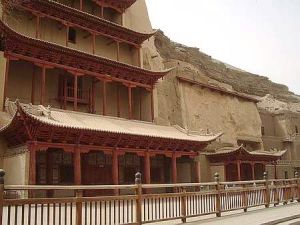 One click after another illuminates colourful scenes of hunters, Buddhas, flying deities, Bodhisattvas and caravanserais painted on the walls of the Mogao caves in northwest China, considered the epitome of Buddhist art -- and now in existential danger. One click after another illuminates colourful scenes of hunters, Buddhas, flying deities, Bodhisattvas and caravanserais painted on the walls of the Mogao caves in northwest China, considered the epitome of Buddhist art -- and now in existential danger.From the fourth century onwards the 492 largely hand-dug caves near Dunhuang, a desert oasis and crossroads on the Silk Road, acted as a depository for Buddhist art for around a millennium. Unesco describes the World Heritage Site as "the largest, most richly endowed, and longest used treasure house of Buddhist art in the world". "Dunhuang is where Chinese, Greek and Roman, Islamic and Indian arts meet," says Mimi Gates, a former director of the Seattle Art Museum who is helping to preserve the caves, and stepmother to Microsoft founder Bill. "When tourists enter the caves, the humidity, the temperature and the carbon dioxide increase abruptly," said Wang Xudong, director general of the Dunhuang Academy. The wall paintings themselves contain "a lot of natural salts that have come out of the rocks over 1,200, 1,500 years, the age of these wall paintings", he explained. If the humidity goes above a critical value, "then the salts can suck the moisture out of the air and start the deterioration process". But authorities must strike a difficult balance between limiting access to visitors and avoiding alienating them, particularly the hundreds of thousands of primarily Chinese tourists whose numbers are steadily rising. "Every child in China in growing up learns about Dunhuang. It is one of the great sites, so when they grow up they want to come here, and they do now that they have the money to," says Neville Agnew, a project specialist at the Getty Conservation Institute who has worked with the academy for 25 years. The digitisation project -- which has been running for decades -- is part of the solution, a grand project to transform the way visitors are received and cut the time they spend inside, even as numbers rise. It is an immense task. The paintings cover 45,000 square metres (485,000 square feet) -- if set in a single mural three metres high, it would stretch for 15 kilometres. Thousands of images are taken of each chamber, using specialised lights to avoid damage, and then laboriously computer-processed to create a precise cyber replica. "Digitising the caves is very difficult," said Wang. "We began in the 1990s but at the time it was a failure. We continued in the year 2000 thanks to technological advances." The key challenge is capturing the freshness of the colours, particularly natural pigments such as vermilion and malachite green, as well as any areas that are not flat, such as corners and sculptures. "We have six working teams here on a very intense schedule. Each team must digitise three to four caves a year," said Wang. "Our goal is to reduce the amount of time that tourists spend in the caves, to minimise the damage that they cause." Once the new system goes into effect next year visitors will be overseen as soon as they reach the airport -- essentially the only convenient entry point for Dunhuang -- and have to stick to a tightly controlled sightseeing circuit. In a domed theatre currently under construction they will view high-definition images of the inside of the chambers, before taking a glimpse inside the real thing -- but only for a limited time. "The typical tour might be 10 caves, and of those 10 caves there would be two or three of these so-called must-see caves," says Agnew. Long after Dunhuang's heyday, the Silk Road eventually fell into disuse and it was largely forgotten by the outside world, with most of the caves abandoned. In 1907 Hungarian-British archaeologist Aurel Stein led an expedition to the area and paid to remove large numbers of manuscripts, paintings and textiles. A French mission under Paul Pelliot acquired thousands of items the following year, and Japanese and Russian expeditions soon followed in their footsteps. But the latest collaboration will preserve Dunhuang for future generations, say those involved, and make the masterpieces available to academics and amateurs around the world online. "The painting is superb, the painting is unbelievable, the paintings are just masterworks of paintings, and in a variety of styles over the dynasties as they changed," said Agnew. "History is here, art is here." Read More @ Source |
|
Posted: 25 May 2013 10:00 PM PDT
by AMY WOLD, The Advocate, May 20, 2013 With their eyes closed, the chant blended into a song punctuated by music of drums, horns and hand bells. With their eyes closed, the chant blended into a song punctuated by music of drums, horns and hand bells.Lobsang Dhondup, a Tibetan monk, said creating a mandala, which is an ancient art form of Tibetan Buddhist, requires rituals, prayers and meditation. These, he said, ensure a friendly environment for the creation of this sacred art. The monks, who are traveling with the Dalai Lama, came to Baton Rouge to create the mandala over the next four days. People are welcome to come and watch construction of the mandala from 9 a.m. to 5 p.m. the rest of the week. Visitors also can participate in an evening talk starting at 7:30 p.m. each night. The closing of the sand mandala when it is destroyed will occur Friday evening after a talk about the symbolism of the sand mandala that starts at 7:30 p.m. Her cousins helped build the temple that sits on a small piece of land just north of Airline Highway, she said, and her family supports the temple. "It was interesting. Totally different culture", Kim Lee said of the opening ceremony. Thay Dao Quang, Abbot of Tam Bao Meditation Center, said he was happy when the monks asked to come to Baton Rouge not only because of the mandala they would create, but also to let the Baton Rouge Buddhist community learn from other outlooks. He explained there are many variations of Buddhist, so Tibetan Buddhist is different from Vietnamese Buddhist. In fact, he said, Buddhist practices differ in the south, center and north of the country. "However, the foundation is the same," Quang said. As the monks started using string and a large wooden compass to lay out the design of the mandala, Sue Ann Conerly, 68, of Greenwell Springs, watched from the side of the room. Although she had never been to the Tam Bao Meditation Center before, she said she drives by it often on her way to and from home. She saw a notice about the opening ceremony in the newspaper and was interested in checking it out. "Very, very interesting," Conerly said after the opening ceremony." "I don't know too much about it other than peace. love and tranquility." She said she planned to come back for some of the lectures throughout the week. Like many of those who attended the opening ceremony, Cathy Coates, of Baton Rouge, had been to hear the Dalai Lama's speak in New Orleans. She said she knew her mother, who is an avid photographer, would love to hear and see the opening ceremony so she brought her along to the meditation center. "I've been to Tibet and how often do you get to see Tibetan monks in Baton Rouge?" Coates said. Another family gathered from across the country to attend the Dalai Lama's visit in New Orleans. Brothers and sisters Frank Lachicotte, of Charleston, S.C.; Charlotte Lachicotte, of Baton Rouge; and Lillian Lachicotte, of San Diego, Calif., had heard of the Dalai Lama's visit and were online to buy tickets as soon as they became available. "We were able to go to the closing ceremony," Charlotte Lachicotte said. The closing ceremony is when the sand mandala is destroyed and all the sand scooped up. In New Orleans, the crowd then made a procession to the Mississippi River, where the sand was poured into the water. "And that's the peace to be spread over the whole world," Frank Lachicotte explained. They attended the opening mandala ceremony in Baton Rouge because they wanted to see the process begin since they'd seen the closing ceremony a few days ago, Charlotte Lachicotte said. "We couldn't get enough," she said. The Tibetan monks will stay through Saturday when the center will be celebrating the Buddha's birthday. Read More @ Source |
|
Posted: 25 May 2013 09:00 PM PDT
by Peter Smith, The Courier-Journal, May 20, 2013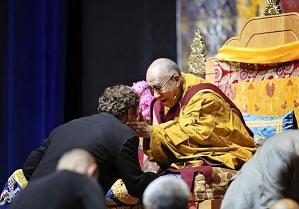 << Michael Fitzpatrick got a blessing from His Holiness the 14th Dalai Lama at the KFC Yum! Center. May 20th, 2013 Kylene White The Courier-Journal << Michael Fitzpatrick got a blessing from His Holiness the 14th Dalai Lama at the KFC Yum! Center. May 20th, 2013 Kylene White The Courier-JournalThe stage filled with monks and nuns sitting cross-legged in straight-backed postures, their robes of various shades reflecting a diverse group of Buddhist ethnic and spiritual traditions. Tibetan monks chanted Buddhist sacred texts in deep, rhythmic tones, which gradually transitioned to a contemplative solo electric cello performance by former Louisville resident Michael Fitzpatrick. The spiritual leader of Tibetan Buddhists sat cross-legged on a custom-made throne, indicating his status as teacher, beneath a large tapestry illustrating the Buddha and other sacred figures. "So, now completed," he said at the end of two long sessions, during which fatigue began to show on some audience members' faces but not on that of the 77-year-old Dalai Lama. "I am hopeful not very tired." While his direct spiritual authority extends only to Tibetan Buddhism - just one branch among many in the religion - his talk drew many from other ethnic and philosophical traditions. Representatives of Chinese, Thai, Vietnamese and other branches were on stage. An estimated 7,000 attended. David Nguyen of California was particularly impressed that a religious leader would be so tolerant of other religions, "how they all get the point across but through different methods. Magnolia Grove Monastery in Mississippi, home to monks and nuns following in the tradition of Vietnamese Buddhist teacher and author Thich Nhat Hanh, sent a vanload of residents on the seven-hour trip to Louisville. Abbot Billy Hoang said the Dalai Lama's talk encouraged the group in its goal to "bring mindfulness and peace for everyone." The title of the Dalai Lama's talk was "Atisha's Lamp for the Path to Enlightenment," a teaching dating back to Tibet. But before delving into the topic, the Dalai Lama spoke more generally on religion and spirituality, saying people who seek material riches can never be satisfied because they "always want more." He said any guest to a family's home can sense if there is affection, making it an enjoyable visit even if the family is poor and has little food to offer. And a rich home "cannot produce affection, even if a lot of decoration," he said. Religions have varying views on such things as whether there is a divine creator, but they share the "same aim, same purpose, to stimulate the practice of love, compassion." He said he tells audiences in countries that are not traditionally Buddhist that he discourages people from converting to Buddhism, saying it can "create more problems, more confusion. Better to keep one's own tradition." He said non-Buddhists should take from his talk any lessons that help them grow in compassion, and he urged Buddhists to keep striving in their spiritual practices."Through familiarization, gradually it become easier," he said. He concludes his visit with a talk to students at the Kentucky Center on Tuesday. Read More @ Source |
|
Posted: 25 May 2013 08:00 PM PDT
by By Shenali Waduge, Eurasia Review, May 24, 2013
Colombo, Sri Lanka -- Sri Lanka with a Theravada Buddhist civilization that protected and fostered Buddhism has much to introspect. With over 70% of the population being Buddhists it is a national shame that we continue to forget the very basic teachings of the Buddha whose message to us was to treat non – human sentient beings with compassion and loving – kindness, as though they were no different to humans with feelings and pain.
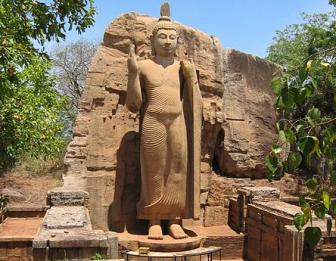 << Avukana Buddha statue from 5th century CE in Sri Lanka << Avukana Buddha statue from 5th century CE in Sri LankaIf animals share emotions no different to ours, is it not a huge embarrassment that in this reputed Buddhist country our elected leaders fall shy of enacting the Animal Welfare Bill tabled in Parliament in 2010 as a Private Member's Bill and which has its genesis in the Animal Welfare Bill drafted and sanctioned by the Law Commission in 2006? We cannot be Buddhists by name There are two mistakes one can make along the road to truth. NOT GOING ALL THE WAY and NOT STARTING – Buddha What sort of legislative reform is the Ministry of Justice supposed to be undertaking when the primary statute in Sri Lanka governing the protection and welfare of animals to this day is an antiquated statute enacted during the British colonial era in 1907 i.e. Prevention of Cruelty to Animals Ordinance, where the maximum punishment for a heinous crime to an animal is a mere Rs. 100 (less than one US Dollar)?. The need to enact the Animal Welfare Bill is further strengthened by the international Petition gathering momentum the world over by the Dharma Voices for Animals launched in the USA. http://dharmavoicesforanimals.org/petitions/ Read More @ Source |
|
Posted: 25 May 2013 07:00 PM PDT
by HANNAH FLEMING, Stuff.co.nz, May 20, 2013
New Plymouth, New Zealand -- New Plymouth's Sri Lankan community brought its culture alive on Saturday in celebration of religious and cultural festival Vesak.
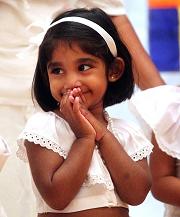 << TALKING TRADITION: Young performer Sethini Koralage, 3, at a Sri Lankan religious and cultural festival in Bell Block on Saturday. << TALKING TRADITION: Young performer Sethini Koralage, 3, at a Sri Lankan religious and cultural festival in Bell Block on Saturday.The festival commemorates the birth, enlightenment and death of Buddha. Organiser Ramitha Fernando said it was similar to what Diwali was to Hindus and what Ramadan was to Muslims. "It is important to celebrate this on a large scale because once you've left your motherland you are isolated. "There are no Buddhist temples in New Plymouth. "It's particularly easy for the young children to forget their culture, their religion and their mother tongue." More than 125 people attended the fifth celebration held in the province, as well as three monks who travelled from Auckland to take part in the ceremony. Sermons followed, and the monks were then offered gifts from the people. Buddhist songs were also performed by children and their parents. Mr Fernando said many different cultures turned up to experience the Buddhist tradition and a good time was had by all participants. "Some of those in our community work as engineers and they brought some workmates along so they were able to come and appreciate our culture and food," he said. "Our plan is to continue this for many years." Read More @ Source |
|
Posted: 25 May 2013 05:00 PM PDT
by Thanachot Anuwan, Pattaya Mail, 24 May 2013
Pattaya, Thailand -- Saha Farms' Ban Sukhawadee and the Phra Yai Chaiyaphum Foundation organized a merit-making ceremony to raise funds for a 20 billion baht Buddhism center in Thailand's northeast.
 Saha Farms Managing Director Punya Chotithewan welcomed Banglamung District Chief Sakchai Taengho, Nongprue Police Superintendent Col. Somnuk Janthages, and Thipakorn Rinthaisongh, president of the Phra Yai Chaiyaphum Foundation, to the grandiose Pattaya mansion May 10. Saha Farms Managing Director Punya Chotithewan welcomed Banglamung District Chief Sakchai Taengho, Nongprue Police Superintendent Col. Somnuk Janthages, and Thipakorn Rinthaisongh, president of the Phra Yai Chaiyaphum Foundation, to the grandiose Pattaya mansion May 10.Guests donate funds for the new Buddhism center in Thailand's northeast.Guests donate funds for the new Buddhism center in Thailand's northeast. Guests donated funds that will go toward construction of a religious center slated to host the world's largest Buddhist statue, among other attractions, in Chaiyaphum's Nafai Sub-district. The 20 billion baht project calls for a biography of Buddha's 500 lives, four pagodas, models of important Buddhist destinations around the world, a 2,500-person sermon hall, a pavilion to accommodate 5,000, lotus swimming pool, 500-rai sake-head statue, parking for 1,000 cars, waterfalls, accommodations for monks and more. Construction is scheduled to begin this year. Read More @ Source |
|
Posted: 25 May 2013 04:00 PM PDT
Xinhua, May 24, 2013
KANDAL, Cambodia -- Thousands of Buddhist monks and Buddhists marched on Friday morning around Preah Reach Trap Mountain, where the relics of Buddha are housed, to celebrate the Visak Bochea's Day, or Buddha's Day.
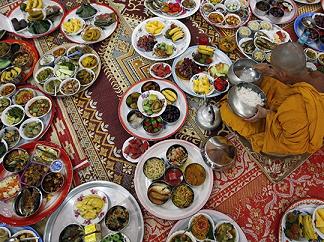 The annually religious ceremony was attended by Great Supreme Patriarch Tep Vong, leader of the Mohanikaya Buddhist sect, and Supreme Patriarch Bou Kry, head of the Thammayut Buddhist sect, as well as Deputy Prime Minister and Defense Minister Gen. Tea Banh. The annually religious ceremony was attended by Great Supreme Patriarch Tep Vong, leader of the Mohanikaya Buddhist sect, and Supreme Patriarch Bou Kry, head of the Thammayut Buddhist sect, as well as Deputy Prime Minister and Defense Minister Gen. Tea Banh.Visak Bochea's Day marked the anniversary of the Buddha's birth, enlightenment and death, said a media statement from the National Committee for Organizing National and International Festivals. It is a public holiday in this Buddhist-dominant country, where about 90 percent of the 14.5 million populations are Buddhists. At the event, lay people prayed to the Lord Buddha by lighting candles, incense sticks and laying flowers before the Lord Buddha' s statues and relics. In addition, they donated foods and money to participating Buddhist monks with the dedication to their deceased relatives. "The celebration is to maintain national identification and tradition and to enhance the key role of Buddhist in Cambodia," the statement said. One of the participants Top Pich, 72, said that she has come to attend this important ritual every year. "As a Buddhist, today is a very important day for me to commemorate my Lord Buddha," she said. "All of my family members are Buddhists and we have followed this practice from generation to generation." Buddhism is the state religion in this Southeast Asia nation. According to the figures of Ministry of Cults and Religion, the country has about 4,400 Buddhist pagodas with more than 50,000 monks. Read More @ Source |
|
Posted: 25 May 2013 03:00 PM PDT
By EDMUND NGO, BEH YUEN HUI and QISHIN TARIQ, The Star, May 24, 2013
KUALA LUMPUR, Malaysia -- Visitors came as early as 7am to the Buddhist Maha Vihara here to commemorate Wesak Day on Friday.
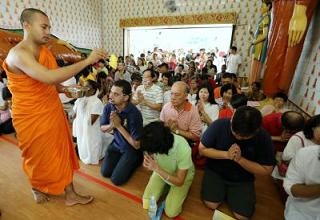 << Devotees at the Buddhist Maha Vihara in Kuala Lumpur performing prayers on Wesak Day. << Devotees at the Buddhist Maha Vihara in Kuala Lumpur performing prayers on Wesak Day.Devotees presented flowers, lit candles, sought blessings and made offerings to the monks to commemorate the birth, enlightenment and death of Buddha. Ng Chun Hoe, a 54-year-old volunteer of the Friends of the Vihara, said the spirit of giving was very important to him as he was happy seeing people smile and hungry folk fed. The manager of an insurance company recounted seeing a boy picking up unlit firecrackers during Chinese New Year some 30 years ago. "The child's family was very poor, he had no toys and barely enough food to eat, so he ended up playing with a dangerous item," said Ng, adding the episode led him to help the needy ever since. Tents selling offerings, candles, flowers, balloons, lotus buds, food and beverages as well as booths recruiting volunteers were set up inside and along the road leading to the temple in Brickfields here. 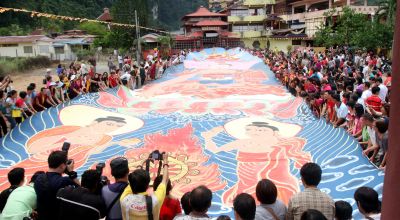 << The thanka, a giant canvas painting of Sakyamuni Buddha, is unfurled at the Enlightened Heart Buddhist Centre in Tambun. << The thanka, a giant canvas painting of Sakyamuni Buddha, is unfurled at the Enlightened Heart Buddhist Centre in Tambun. Over in IPOH, hundreds of devotees unfurled a thanka - a giant canvas painting of Sakyamuni Buddha - at the Enlightened Heart Buddhist Centre in Tambun. It is a traditional practice to unfurl the thangka in the temple compound to draw power from the sun. Devotees also ran under the 60m by 12m canvas to receive blessings from Buddha. Meanwhile, in PETALING JAYA, DAP adviser Lim Kit Siang called an end to race politics and ease escalating racial polarisation. "My wish on Wesak Day is for all leaders, starting with the Prime Minister (Datuk Seri Najib Tun Razak), to walk the talk of their Wesak Day messages. "I urge Najib to show leadership by example in his call to the people to set aside their differences at all levels of society," he said in a statement here Friday. He challenged Najib to demonstrate his political will and ease escalation of racial polarisation and for Barisan Nasional component parties to open their membership to other races to make them Malaysian-based and not raced-based. Lim also wished all Buddhists in Malaysia a happy and enlightening Wesak Day and non-Buddhists a happy holiday. "The best way to celebrate Wesak Day is to truly and sincerely strive to follow his teachings, reiterate the determination to lead noble lives, develop the mind, practice loving kindness and bring peace and harmony to humanity," he said. Read More @ Source |
|
Posted: 25 May 2013 02:00 PM PDT
The Financial Express (Bangladesh), 24 May 2013
Dhaka, Bangladesh -- President M Abdul Hamid Advocate on Thursday urged all to be vigilant against the reactionary bigots with a view to maintaining traditional communal harmony in the country at any cost, reports UNB.
The President and his wife welcomed the guests and exchanged greetings with them. President Abdul Hamid said: "Bangladesh is a country of communal harmony. The country came into being with the spirit of building a non-communal society free from oppression? for that secularism was identified as one of the main principles in the constitution of 1972." He said: "We've to keep in mind that people of the country are pious, but not bigots." The President mentioned that secularism does not mean non-religiousness. Secularism means to work for national development through pursuing respective religion. The time has come to work for building Bangladesh as non-communal country as dreamt by father of the nation Bangabandhu Sheikh Mujibur Rahman, he said. "The state and festival are for all irrespective of religion. All of us-Hindu-Muslim-Bouddha-Christian-are Bangalis. Our today's pledge will be to advance the country towards development and prosperity with the joint efforts of all." Abdul Hamid noted that from time immemorial, the Buddhist community has been contributing to the country's education, culture and socio-economic development. "Different archeological sites in different parts of the country bear the proof," he said. Industries Minister Dilip Barua, State Minister for Religious Affairs M Shahjahan Miah, ambassadors and high commissioners of different countries including Myanmar, Bhutan, Vietnam, Thailand and Sri Lanka as well as representatives of various international organisations and professionals of Buddhist community attended the reception. Secretaries to the President's office were present on the occasion. BSS adds: Members of the Buddhist community here today celebrated their most sacred and largest festival Buddha Purnima in the city and elsewhere in the district with traditional enthusiasm and solemn devotion. Buddhists celebrate the Purnima marking the three significant events, took place in the life of Lord Buddha- the birth, enlightenment and passing away. Lord Buddha was born on the Full Moon day in 563 BC, attained supreme enlightenment and nirvana (the cycle of rebirth) on the same day. The festival was celebrated in all monasteries and different Buddhist organizations with elaborate programmes. The day's programmes were heralded with hoisting of the national and religious flags atop all monasteries in the dawn and chanting of the sacred verses from the Tripitaka. The Buddhist devotees also offered fruits, flowers, candles etc to statues of Lord Buddha throughout the day. Prayer meets, sermons on the life of Gautam Buddha, religious discourse, continuous recitation of Buddhist scriptures, group meditation, processions, worships of the statue of Buddha were the highlights of the day's programmes. In the city, the main religious congregations were held at Nandankanan Buddhist temple, Katalganj Nabapandit Vihar, Purnachar International Buddhists Monasteries at Devpahar, Sarbajanina Buddha Vihar at Momin road and Biswamoitry Buddha Vihar at Agrabad. The Buddhists in Chittagong organized a two-day programme ahead of Buddha Purnima. Deputy Commissioner of Chittagong Abdul Mannan will inaugurate a religious procession at Nandankanan Buddhist Monastery at 8 am Friday. To mark the day, local dailies also brought out special articles while Bangladesh Betar and Bangladesh Television, Chittagong centres aired special programmes highlighting importance of the festival. To mark the occasion, special issues of a good number of periodicals of the community like Amitabh, Sombodhi, Krishti, and Arya were brought out. Read More @ Source |
|
Posted: 25 May 2013 01:00 PM PDT
The Jakarta Post, May 24 2013
Jakarta, Indonesia -- Different people take different paths in an effort to attain perfection. While a few people are endowed with extraordinary talent or intelligence to invent or create, most people need not worry about that and simply follow or apply what the inventors or creators have discovered for us.
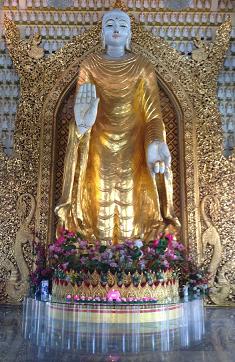 << Waisak offers precious momentum for Buddhists to apply - and not necessarily to simulate - what he taught and demonstrated during his lifetime. << Waisak offers precious momentum for Buddhists to apply - and not necessarily to simulate - what he taught and demonstrated during his lifetime.The same is true in the religious realm. While religion and religious teachings were in place hundreds or even thousands of years ago, people of the latter and present times should just put in practice what religion and religious teachings have taught and provided for them. The celebration of Waisak, or Buddha's Day of Enlightenment, on Saturday is therefore the perfect time for Indonesians, particularly Buddhists, to take a break from their daily routines and refresh their minds with noble ideas and teachings of Siddhartha Gautama in the pursuit of a balanced life and spiritual perfection. Waisak, essentially a commemoration of three important events in the life of Siddhartha, namely his birth, his enlightenment after which he became Buddha (literally meaning "the enlightened one") and his death, therefore offers precious momentum for Buddhists to apply - and not necessarily to simulate - what he taught and demonstrated during his lifetime. Born the prince of a small kingdom in India, Siddhartha was showered with riches and shielded from the poor, the sick, monks and death, through to adulthood. However, his eventual encounter with those whose lives had been touched by sickness, death, poverty and monks made him realize that his life was not eternal and he then decided to abandon his riches and left his wife and young son to live a monastic life. And in such a plural, multicultural and multiethnic Indonesian society, with the yawning gap between the rich and the poor, truly implementing the teachings of Buddha will at least help soothe the impact of such critical differences on the nation and benefit the adherents - individually - in their pursuit for religious perfection. Read More @ Source |
|
Posted: 25 May 2013 12:00 PM PDT

The Shambhala Sun is pleased to present a livestream of Dzongsar Khyentse Rinpoche's teachings on Chögyam Trungpa Rinpoche's foreword to The Rain of Wisdom, a collection of songs of realization from the Kagyu lineage of Tibetan Buddhist. The teachings will take place on Friday, May 31 and Saturday, June 1 in Halifax, Nova Scotia. They will be the first of the Shambhala Sun's new "Direct Dharma" series of livestreamed talks, offering access to premiere Buddhist teachers from lineages across North America.
The livestream will be free to watch — information on how to access it will be made available here and on the homepage of ShambhalaSun.com on the morning of Friday, May 31.
To learn more about Dzongsar Khyentse Rinpoche, read these articles from the Shambhala Sun archives.You can read more about and from Chögyam Trungpa Rinpoche on the Shambhala Sun's Chögyam Trungpa Spotlight Page. Read More @ Source |